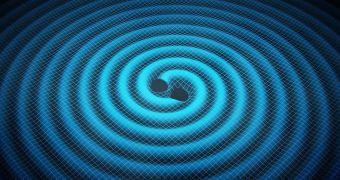In a paper published in the October 18 issue of the top journal Science, researchers at the Commonwealth Scientific and Industrial Research Organization (CSIRO) and the University of Melbourne describe how a new study used constructs known as pulsar-timing arrays to try and detect gravitational waves.
The research was unable to pinpoint the phenomenon, but made some interesting discoveries in the process.
Gravitational waves are massive, slow-traveling ripples in the fabric of space-time, thought to be caused by the merger of black holes at the core of distant, active galaxies. The singularities already distort space-time on their own, but tend to chafe it even more when they collide with each other.
The distortions thus created travel over monumental distances, and pass through solid matter without being detected. A number of methods of detecting them have been proposed, but one of the most promising is the use of massive pulsar-timing arrays (PTA).
The Parkes PTA is such a structure. It is composed of 20 pulsars, which are in essence neutron stars that spew out massive amounts of radiations through their poles. Unlike other neutron stars, pulsars spins very fast, and resemble cosmic lighthouse when seen from Earth. Another important aspect is that their pulses occur at very precise intervals.
The pulsars in the Parkes PTA are spaced thousands to millions of light-years away from each other. Theoretically, gravitational waves should slowly contract and expand the distance between these dead stars as they pass. Telescopes on Earth should be able to measure these changes by carefully watching how the stars pulse over time.
“Right now, the focus in the pulsar-timing array communities is to develop more sensitive technologies and to establish long-term monitoring programs of a large ensemble of the pulsars,” explains NASA Jet Propulsion Laboratory (JPL) expert Walid Majid.
He holds an appointment as the principal investigator of the JPL pulsar-timing program, which is conducted with the Deep Space Network, an array of large, sensitive radio telescopes.
“All the strategies for detecting gravitational waves, including [the Laser Interferometer Gravitational-Wave Observatory], are complementary, since each technique is sensitive to detection of gravitational waves at very different frequencies,” the investigator adds.
CSIRO astronomers argue that the Parkes PTA will most likely become sensitive enough to detect gravitational waves within the next 10 years.

 14 DAY TRIAL //
14 DAY TRIAL //